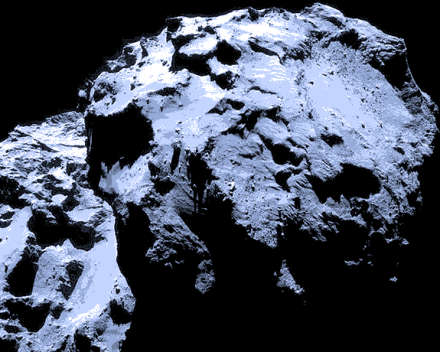Scientists: Possible biomarker in space?

“This is the first detection ever of a saturated organohalogen in interstellar space,” explains a news release from the University of Cologne, Germany.
But as researchers explore the significance of their finding, they say the compound may not be as good a marker of life as had been thought. Here is the rundown:
What did scientists find? Researchers discovered traces of the chemical compound Freon-40, an organohalogen, around the comet 67P/Churyumov-Gerasimenko in our solar system and around a star approximately 400 light-years away, according to the University of Cologne news release.
How did they find it? The team, which included scientists from Harvard University, the University of Cologne and the University of Copenhagen in Denmark, among others, used information captured by the ALMA (Atacama Large Millimeter/submillimeter Array) in Chile and an instrument on the European Space Agency’s Rosetta spacecraft.
What is an organohalogen? Organohalogens are “a class of molecules that contain at least one halogen atom bonded to carbon,” according to the journal Nature Astronomy, which published the research on Oct. 2. Abundant on Earth, they are produced primarily in industrial and biological processes, the journal explains.
Why are scientists looking for this compound? In recent years, scientists have identified more than 3,000 exoplanets, the University of Cologne news release explains. It is one thing to know that planets are out there, and another to confirm that some form of life exists. Scientists are looking for chemical markers that indicate life.
Why did scientists think this compound might point to extraterrestrial life? Freon-40, also known as methyl chloride and chloromethane, “is formed by organic processes on Earth, so it has been considered as a marker of extraterrestrial life,” the news release states. (An organic process is a process occurring in living organisms.)
Are they sure that Freon-40 points to the presence of extraterrestrial life? In a word, no. Instead, it “may be an important element in the little-understood chemistry involved in the origin of life,” according to the news release.
The article: "Protostellar and Cometary Detections of Organohalogens," is published in Nature Astronomy, by Edith C. Fayolle, researcher with the Harvard-Smithsonian Center for Astrophysics in Massachusetts, et al.
Related:
Planets in habitable zone could have water
In brief: Pollution could aid in search for life
If you would like to comment, like us on Facebook and tell us what you think.

